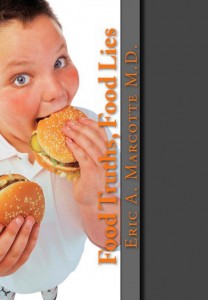October 8th, 2011 by John Mandrola, M.D. in Health Tips, Opinion
No Comments »

I recently wrote about the incredible sensations that come with vigorous exercise. Perhaps it was the post ride cannabinoid flurry, but it’s possible that I went too far in suggesting that ‘we’ (doctors, patients, the whole of Western Society) default first to pills before healthy living.
Two commentors called me out on this snark. They wrote about valid points.
One comment focused on the fact that her AF medicines were causing side effects that made vigorous exercise difficult. The second objected to my inference that exercise alone could substitute for the many benefits of modern medicine.
To the idea that medicine Read more »
*This blog post was originally published at Dr John M*
August 18th, 2011 by Dr. Val Jones in Book Reviews
No Comments »
 Food Truths, Food Lies, written by family physician Eric Marcotte, M.D., may be the most refreshingly evidence-based diet book of the decade. You will not find a single mention of super-foods, magical berries, or supplement “must-haves” in the entire book. What you will find is the cold, hard truth about why many Americans are overweight, and what it takes to become a healthy eater.
Food Truths, Food Lies, written by family physician Eric Marcotte, M.D., may be the most refreshingly evidence-based diet book of the decade. You will not find a single mention of super-foods, magical berries, or supplement “must-haves” in the entire book. What you will find is the cold, hard truth about why many Americans are overweight, and what it takes to become a healthy eater.
Marcotte writes for the average American – his simple language, matter-of-fact tone, and regular reminders of what the reader has learned, make for a quick and memorable read. Although it’s clear that Marcotte has carefully distilled his dietary advice from the scientific literature, he refrains from burdening the reader with too many footnotes and references. Instead, he has created a kind of Cliff’s Notes of nutrition, having done the “heavy sifting” for us. What remains are the most basic principles underlying all healthy eating, such as:
*You can’t exercise your way to weight loss (i.e. you can’t outrun your own mouth – it’s much easier to eat more calories than you burn) Read more »
August 6th, 2011 by Dr. Val Jones in Opinion, True Stories
7 Comments »
 I’m feeling rather nauseated today. This is my fifth day of a high-protein, low-fat, low-carb diet, and I have already developed a deep-seated hatred of egg whites. My regimen includes uncomfortable quantities of grilled chicken breast, fat-free cottage cheese, Greek yogurt, and egg protein, occasionally garnished with a lettuce leaf or perhaps a blueberry. Just yesterday I had to drink a plastic test tube of liquid protein to meet my goals (see offending product image to the left). It looked like a blood-tinged albumin sample, and tasted like orange flavor crystals with a splash of soy sauce.
I’m feeling rather nauseated today. This is my fifth day of a high-protein, low-fat, low-carb diet, and I have already developed a deep-seated hatred of egg whites. My regimen includes uncomfortable quantities of grilled chicken breast, fat-free cottage cheese, Greek yogurt, and egg protein, occasionally garnished with a lettuce leaf or perhaps a blueberry. Just yesterday I had to drink a plastic test tube of liquid protein to meet my goals (see offending product image to the left). It looked like a blood-tinged albumin sample, and tasted like orange flavor crystals with a splash of soy sauce.
I know that the scientific literature (if we distill it and perhaps oversimplify it a bit) seems to suggest that there may be a short-term advantage to high-protein diets in terms of weight loss, but that this advantage fades after a year. Yet almost every trainer and athlete I’ve encountered keeps telling me that the only way to get “really lean” is to eat unimaginable amounts of protein, avoid refined carbs, dramatically limit the complex carbs, and dial down the fat intake. Essentially, I must be reduced to swilling test tubes of orange-soy “albumin.”
When I strenuously protested the diet plan presented to me by my trainer, she simply said, “If you care what food tastes like then you’re not serious about losing fat.”
“Well how long do I need to consume 50% of my calories as protein?” I asked meekly, assuming that there would be an end point in sight. Read more »
July 3rd, 2011 by admin in Health Tips
No Comments »

What do slouching, back pain, and a middling forehand or weak shot off the tee have in common? Often it’s a weak core—the girdle of muscles, bones, and joints that links your upper and lower body. Your core gives you stability and helps power the moves you make every day. Whether it’s bending to pick up a laundry basket, swinging a golf club, paddling a kayak, or reaching to pull a vase from the top shelf of a cabinet, a strong and flexible core makes the move more fluid, efficient, and robust. Strong, well-balanced core muscles can also improve your posture and help prevent back injuries. And if back pain does strike, core exercises are usually part of the rehab regimen.
Core Muscles

Click image to enlarge.
Your core is composed of many different muscles in the abdomen, back, sides, pelvis, and buttocks. These muscles work together to allow you to bend, twist, rotate, and stand upright. |
For all these reasons, more and more people are incorporating core exercises into their fitness routines. If you’re among them, or planning to be, it’s critical to pay attention to proper form. Read more »
*This blog post was originally published at Harvard Health Blog*





 I’m feeling rather nauseated today. This is my fifth day of a high-protein, low-fat, low-carb diet, and I have already developed a deep-seated hatred of egg whites. My regimen includes uncomfortable quantities of grilled chicken breast, fat-free cottage cheese, Greek yogurt, and egg protein, occasionally garnished with a lettuce leaf or perhaps a blueberry. Just yesterday I had to drink a plastic test tube of liquid protein to meet my goals (see offending product image to the left). It looked like a blood-tinged albumin sample, and tasted like orange flavor crystals with a splash of soy sauce.
I’m feeling rather nauseated today. This is my fifth day of a high-protein, low-fat, low-carb diet, and I have already developed a deep-seated hatred of egg whites. My regimen includes uncomfortable quantities of grilled chicken breast, fat-free cottage cheese, Greek yogurt, and egg protein, occasionally garnished with a lettuce leaf or perhaps a blueberry. Just yesterday I had to drink a plastic test tube of liquid protein to meet my goals (see offending product image to the left). It looked like a blood-tinged albumin sample, and tasted like orange flavor crystals with a splash of soy sauce.









